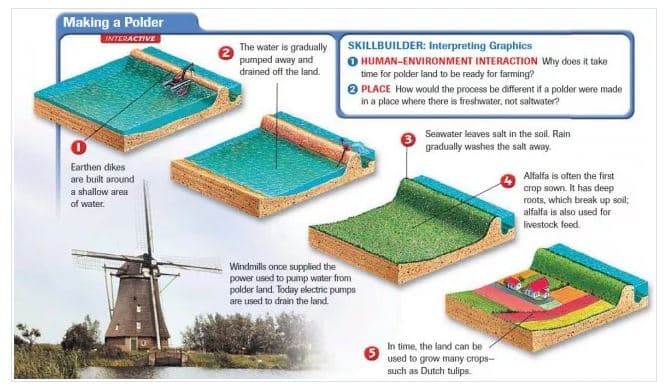If you are asking what is human-environment interaction? Hey!!! You are not alone. Often times I find myself asking what human-environment interaction means. Well, there are many articles on this subject. Below s the table of content.
Table of contents
Human-Environment Interaction Definition
According to Marten 2001, He defined human-environmental interaction is the interaction between the human social system and the rest of the ecosystem.
The human social system and the ecosystem are very complex adaptive systems. This is because they both have many parts, and there are many connections between these parts.
They are adaptive because they have a lot of feedback structure that enhances survival in a constantly evolving environment.
Read this: Best Geology Schools in the World | 2023
Picture of Human-Environment Interaction 2023

For one to really understand and analyze the human-environmental interaction, it is very important that you are aware of the specific behaviours or characteristics of the human social system. The type of society an individual belongs to strongly influences the way they behave, their attitude, and thus their impact on the ecosystem.
Some of the important characteristics of the human social system that greatly affect the ecosystem include:
- population size
- social organization
- values
- technology
- wealth
- education
- knowledge and many more
From the above-listed factors, people’s values and knowledge strongly influence their “View of Life“, and as such, define the way they act. However, the available technology limits the choice of possible actions.
People often adjust the environment to suit their own purpose and benefit from it; this is otherwise called ECOSYSTEM SERVICES.
These ecosystem services are important for human well-being. For instance, the provision of resources like water, timber, food, energy, information, land for farming, and many more. Hence, people use these resources to affect their environment in ways they don’t know.
Moreso, individuals rearrange the existing ecosystems to create new ones that will be more effective in serving their needs.
The Millenium Ecosystem Assessment (MA) analyzed how Ecosystem Services and constituents of human well-being are interlinked. The MA research program started with support from the United Nations in 2001.

Check this: What Does an Ethologist Do? Salary, Requirements, Schools
What are Examples of Human-Environment interaction?
Studies of human-environment interactions are important because they provide us with a better understanding of how people have affected their environment in the past and what may be done to address the environmental problems we currently face.
Below are examples of Human-Environment interaction:
#1. Agriculture
Humans use the land for a variety of reasons, such as crop cultivation or commercial forestry, which alters the vegetation, landscapes, wildlife habitat, patterns of soil erosion and buildup, and the flow and drainage of water.
#2. Human-built structures
Urbanization has altered the way land is used, such as by increasing the quantity of impervious surface, which causes more water to flow off, producing erosion, floods, and silting effects on streams.
Additionally, factories convert raw materials into completed products while frequently discharging hazardous waste and byproducts into the environment, contaminating air and water supplies and negatively influencing human health and natural ecosystems.
#3. Industrialization
Chemicals are extracted from the Earth in enormous amounts for use in industrial operations. Without adequate treatment or disposal, they can seriously harm land animals, soil, water, and air when released into the environment.
#4. Roads & Transportation
Roads are a crucial means of transportation, but because of their impervious surface, they frequently have a negative impact on the surrounding landscape. Other physical repercussions of pollution include noise pollution, air pollution, etc.
#5. Climate Change
One of the most popular geological topics today, climate change, has been the subject of in-depth research for many years. Studies conducted over the past century have demonstrated that humans have had a significant impact on the patterns of the world’s climate.
A few examples of human influences on climate change are greenhouse gas production, deforestation, and changes in land use.
How Does Society Depend on the Environment?
Humanity is reliant on the environment in a variety of ways inside society. The environment’s resources and services have the most significant role in how this happens.
Food, water, a stable climate, clean air, and raw materials are all necessities for existence. This is an example of how human-environment interaction takes place.
Ways People Depend on the Environment
Coevolution and Coadaptation
The unending process of change and mutual adjustment between the human social systems and the environment is called coevolution and coadaptation. Nonetheless, the environment on its own influences human activities.
In this case, human social systems have to adapt to their specific environment. An example of human-environment interaction, in this case, can be seen through natural phenomena like storms and earthquake, which forces human to respond.
Also, these natural occurrences can either be directly or not primarily a result of human actions and, in turn, influence human behaviour as people respond to new situations.
Drivers-Pressures-State-Impact-Response
The Drivers-Pressures-State-Impact-Response (DPSIR) model was first developed by the European Environment Agency(EEA), and it was used to manage and assess all kinds of environmental problems. Many countries and European institutions adopted the conceptual framework.
This model identifies those casual links between environmental degradation and human activities. It distinguishes several categories of indicators within the model to explain how the state of the environment changes due to human activities.
Hence human activities generate or mitigate pressure on the environment. The major forces which initiate human activities are mainly the socio-economic and socio-cultural forces.
The following infographic explains the DPSIR process:

Also, read this: 10 Best Online Masters In Graphic Design Programs | Schools, Requirements, Cost
Human Environment Interaction in the USA and Canada
A HUMAN PERSPECTIVE The sun-baked American Southwest was a harsh environment for its early inhabitants, the ancestors of today’s Pueblo peoples. But these early settlers made good use of available resources. From the land, they took clay and stone building materials.
They built multi-room, apartment-like dwellings in cliffs. This gave protection against daytime heat, nighttime cold, and human and animal enemies. From plants and animals, the early settlers got food and clothing. They survived because they adapted to their environment.
Human environment interaction example In USA and Canada
Before humans came, North American landforms were changed only by natural forces, such as weathering and erosion. That changed when the first settlers—the ancestors of the native peoples of North America— arrived thousands of years ago.
Settlement
The first inhabitants of the area of North America, now known as the United States and Canada, were nomads – people who moved from place to place. Most archaeologists believe that they probably migrated from Asia over Beringia, a land bridge that once connected Siberia and Alaska.
These migrants moved about the land. They hunted, fished, and gathered edible wild plants. Since water was necessary for survival, these first Americans made temporary settlements along coastlines and near rivers and streams.
They adjusted to extremes of temperature and climate. They also adapted to the region’s many natural environments, including mountains, forests, plains, and deserts.
Human Environment Interaction in Africa.
Africa is known for its unique topography (the study of the shape and features of land surfaces), and texture has, over the years, influenced the human social system in so many ways we can’t even imagine.
For example, oil spillage in Nigeria, where human activities have led to loosing of agricultural land to oil spillage and the Desertification of the Sahel,
The Sahel means “shore of the desert” in Arabic. You can see that the Sahel is a narrow band of dry grassland that runs east to west along the southern edge of the Sahara. People use the Sahel for farming and herding.
Since the 1960s, the desert has spread into the Sahel. This shift in the desert is called desertification. Desertification is an expansion of dry conditions into moist areas that are next to deserts.
Normally, it results from nature’s long-term cycle, but human activity is speeding up the process.
Also, you can check this: 10 Best Volunteering Virginia Beach Opportunities In 2023
Human-Environment Interaction in Europe |European Human-Environment Interaction.
European countries such as Germany, Spain, France, Switzerland, Greece, Netherlands, etc., have completely altered the European landscape over the course of the last 10,000 years through the cultivation of agricultural land and the extraction of resources from the environment.
This modification of Europe’s natural environment has brought both positive and negative changes. For instance, an old saying declares, “God created the world, but the Dutch created Holland.” (Holland is another name for the Netherlands.) Because the Dutch needed more land for their growing population, they reclaimed land from the sea.
At least 40 per cent of the Netherlands was once under the sea. Land that is reclaimed by diking and draining is called a polder. This activity is one of the ways humans interact with their environment.
Here are infographics for Human environment interaction in Europe.

FAQs On The Human Environmental Interaction 2023
According to Marten 2001, He defined human-environmental interaction is the interaction between the human social system and the rest of the ecosystem.
Human-environment interactions include deforestation, energy resources, water use, waste, pollution, tourism, and urban expansion.
The five common forms of social interaction— are exchange, competition, conflict, cooperation, and accommodation.
Humanity depends on the environment in the following ways: Food, water, a stable climate, clean air, and raw materials.
References
- Studysmarter.us – Human-Environmental Interaction
- Environment.social – What is Human-Environment Interaction?
- Geography.name – Europe: Human–Environment Interaction
Writer’s Recommendations
- WASCAL Doctoral Research Programme in Climate Change and Land Use
- 13 Best Colleges For Environmental Science
- 10 Free Masters Degree For International Students
- What Can I Do With a Human Resource Management Degree? Career & Salary
- Study in Australia: University Of Melbourne Human Rights Scholarship For International Students





